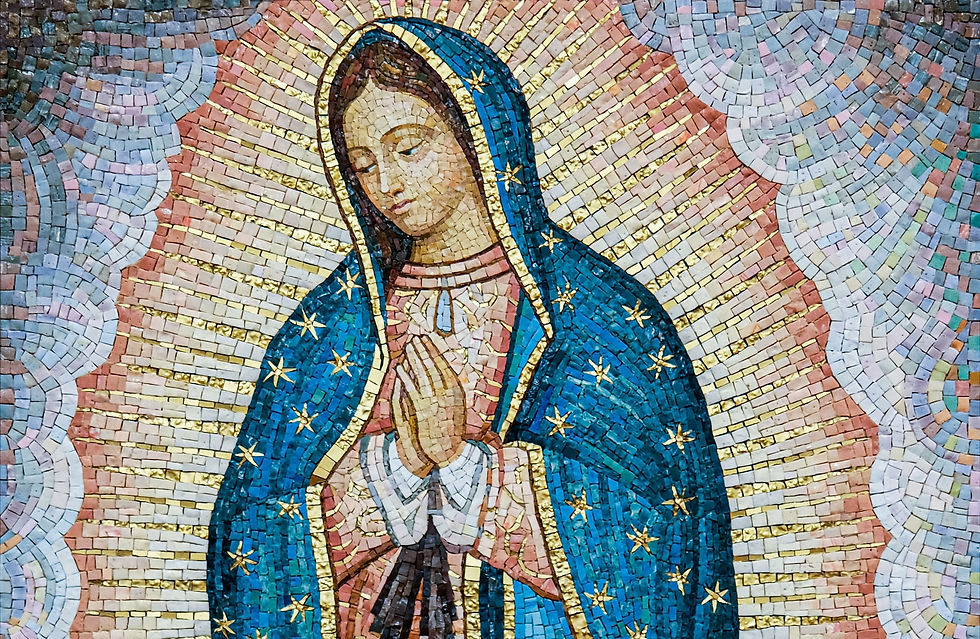He Slept on a Church Floor to See Pope St. John Paul II — Now He’s Building a Church in His Honor
- Jacqueline Gilvard Landry

- Oct 22
- 5 min read
Inspired by his encounter with Pope St. John Paul II at World Youth Day Denver in 1993, one local Catholic architect now builds and beautifies churches nationwide.

It all started with sleeping on a church floor to see Pope St. John Paul II at World Youth Day 1993 in Denver.
That teenage future architect, Adam Hermanson, never would have imagined he’d one day go on to build the saintly pope’s namesake church, St. John Paul II Parish in Thornton.
“When I was a 16-year-old, I jumped in a van with maybe a dozen other high schoolers and headed down to World Youth Day in 1993 in Denver,” he said. “For three and a half days, I’m listening to this super charismatic man dressed in white telling me to ‘be not afraid, be not afraid,’ and I was just utterly transformed by the universal picture of the church … and now we’re praying to him in Heaven for the success of these projects that are under his patronage.”
Three years prior, at age 13, he decided to become an architect after listening to his seventh-grade teacher regale their class with stories of her daughter’s architecture studies at Montana State University. Hermanson said he had some proclivities in art and engineering, and “realized that architecture was this beautiful blend of the two.”
“Now fast forward a few years,” he said, “and I’m 16 years old and sleeping on the floor of a church … and God was probably smiling over World Youth Day, thinking, this young man has no clue that in the future, I’m going to ask him to design a parish church, right in the shadow of Mile High Stadium [where WYD events were held], under St. John Paul II’s patronage.”
Having recently broken ground on their new church, St. John Paul II Parish in Thornton was established in 2017 and has, since then, shared space with the nearby Frassati Catholic Academy. Earthwork for utilities and streets is underway, and the foundations for the church will be built by year-end, Hermanson said. They will begin the vertical structure of the church in 2026.
St. John Paul II Parish’s pastor, Father James Spahn, has had an untiring commitment to the project, Hermanson said, finding new resources and artists. In addition to mosaics, stone carvings and more, there will be relics of St. John Paul II under the altar and a place for his veneration in the church.
This is phase one of the handsome, hilltop 550-seat church — visible for miles around, facing the Front Range and its stunning views.
“When you come out through the doors on the west, you’ll see Long’s Peak and Mt. Meeker, which is where John Paul II went to pray and hike during World Youth Day,” he said. “This church faces that location where John Paul II recreated and prayed when he was here … in the model of Christ.”
(Photos provided)
A Secular Education Blossoms into a Career in Sacred Architecture
Hermanson’s love for sacred architecture became apparent when he studied at the Catholic University of America in Washington, D.C., on an archdiocesan scholarship. He said the campus is home to the beautiful Basilica of the National Shrine of the Immaculate Conception, a “really diverse expression of sacred architecture, crystallized in one building.”
He was on the campus ministry team at the university and was discerning a call to the priesthood at that time as well, Hermanson said.
Since Catholic University did not offer a concentration or minor in sacred architecture, he had to pursue it outside of school, as a supplement to his general architecture studies. He would later go on to study at Harvard University, where, for his master’s thesis, he designed a hospice, which relied on St. John Paul II’s Theology of the Body. His goal was to show “the role of architecture to the service of the human person and human family when our bodies are failing.”
At the same time, he was establishing his own family. While at Harvard, he became engaged to his junior high school sweetheart, who was studying at Boston University. After graduating, the Hermansons would move to Colorado to be closer to family. Today, he and his wife have six children aged 11 to 24, a grandchild and another grandchild on the way.
Once in Colorado, Hermanson worked in a secular architecture firm from 2002 to 2006 but wanted to pursue sacred architecture. So, he founded his current firm, Integration Design Group (IDG).
“The hope from the very beginning was to start a design firm that could provide services to the Church to help her renew her sacred spaces,” he said.
Inspiration from ‘What’s Been Beautifully Done Before’
Hermanson said his vision for his projects stems from an awareness of the aspects that make a site and location special, including the patronage of the church, particular devotions or special wishes of the pastor and inspiration from “what’s been beautifully done before.”
Hermanson recalled his first project in the Archdiocese of Denver, an adoration chapel at Holy Trinity Parish in Westminster, under Father John Hilton, then the parish’s pastor. When they dedicated the chapel, he said, “These little grandmas came over and said, ‘Are you the architect?’ and I said, ‘Yes,’ and they just hugged me,” he said. “I remember thinking, ‘Lord, if this is my recompense, I will do this forever.’”
Subsequent expansion and beautification of the church building at Holy Trinity became IDG’s “calling card” with other priests and parishes, Hermanson said.
With many projects to choose from, Hermanson said his favorite was another endeavor with Father Hilton, St. Mary Parish in Aspen. He is also very proud of IDG’s work at Holy Name with Father Daniel Cardo, as well as projects at Our Lady of Lourdes Parish in Denver. Among IDG’s other undertakings are work at All Souls Parish in Englewood, St. Peter Parish in Greeley, St. Gianna Molla Parish in Denver, St. Vincent de Paul Parish in Denver and more. Hermanson said his work relies on the generosity of benefactors, big and small.
Adding Polish to God’s Creation
Hermanson said ultimately, he simply adds the polish to God’s projects.
“We’re pulling stones and mortar and wood of the earth, and we do a little bit to shape and polish them and put them into place, but it’s really what God has been doing for a million years on that piece of marble,” he said. “It’s all co-creation and co-participation in what God is doing. That’s the cool eucharistic reality of the ‘fruit of the vine and work of human hands.’ He lets us participate in making beautiful things.”


















